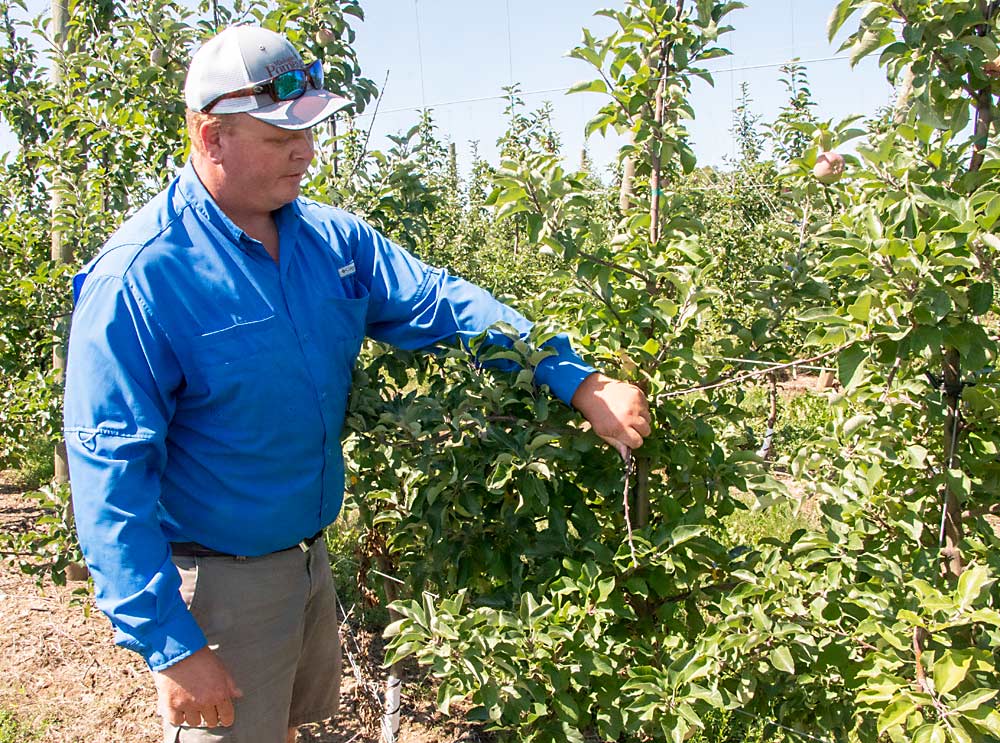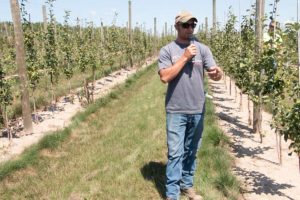
Walking through a block of Fujis at New Leaf Orchards in August, you’d be forgiven for thinking it had problems with fire blight. From the green, certain branches poked out with dead, brown leaves.
Upon closer examination, however, owner Bill Nyblad reveals that the cause of the dead leaves isn’t fire blight: He and his crew deliberately broke those branches to slow their growth.
Nyblad walked the Michigan Pomesters through his Kent City, Michigan, orchard Aug. 6, during the group’s annual summer tour. The Pomesters visited three orchards near Kent City, and drove through a few more in their vehicles, to study innovative growing and training systems in Western Michigan’s Fruit Ridge, the state’s biggest apple-growing region.
Nyblad planted the Fuji block on Nic.29 in 2018. He got the idea for breaking branches from his brother, Gunnar, who experimented with hedge cutting and other techniques in a test plot. Once he saw it in action, Nyblad started refining the breaking technique, trying to figure out the best timing.
Breaking slows down the branches’ strong growth before they start producing fruit spurs, he said. In spring of third leaf, Nyblad and his crew break the powerful, upright-growing branches that need to be cut off either that year or the next. The branches will either survive the break and heal at a flat branch angle, or they will slowly die — slowing the regrowth behind the break and creating a smaller, calmer and more fruitful branch.
“Perfect timing for breaking is the very first green tip you can see,” he said. “With hopes that you have warm weather on the way to heal.”
The weather was too cold at green tip in 2020, so Nyblad waited longer than he would have preferred to start breaking.
Nyblad said he and his crew successfully broke anywhere from 50 percent to 70 percent of the Fuji branches, depending on who was doing the breaking.
“You have to train your men well,” Nyblad said. “It’s a very technical break. If you break it too much, it will bend down too far. If you break it just right, you can tip down every limb that you don’t want to be vertical.”
Phil Schwallier, owner of Schwallier’s Country Basket in Sparta, Michigan, and a retired Michigan State University Extension educator, was on the tour. He said branch breaking is a fairly common training technique in Washington state and is one that he’s tried himself. It reduces vigor and should make the tree more fruitful.
“Branch breaking can be used on any tree at any age to reduce vigor,” Schwallier said. “It’s usually done on high-density orchards, but also can be done on vigorous low-density orchards.”
A vigorous variety such as Fuji is a good candidate for branch breaking, as it tends to grow big limbs with too little fruit. More fruitful varieties probably don’t need it, he said.
When breaking branches, you don’t want to snap the limb completely off and get a new shoot. You just want to crack the limb and leave a broken tip to influence its future growth, Schwallier said.
It can be an effective training technique, but Schwallier isn’t sure if the reward is worth the extra labor costs.
—by Matt Milkovich







Leave A Comment